40 Science Trivia Questions

Welcome, curious minds and trivia lovers! Have you ever wondered why the sky is blue, or if cats really do have nine lives? (Spoiler: they don’t, but they do seem to defy gravity.) Whether you’re a science whiz or someone who just likes to pretend they know what “quantum” means, we’ve got a treat for you.
We’ve gathered some science trivia questions that’ll make you say, “Wait, is that true?” and “How did I not know that?!” You might learn a thing or two, or just laugh at how weird and wonderful our universe is.
Let’s check them out.
Science Trivia Questions
Q. What is the name of the effect that causes the frequency of a wave to change based on the relative motion between the source and the observer?
A. Doppler Effect
The Doppler Effect occurs when there is a change in the frequency or wavelength of a wave in relation to an observer who is moving relative to the wave source. For example, as a car with a blaring horn passes by, the pitch of the horn appears to change due to this effect.
Q. Which chemical element has the highest melting point?
A. Tungsten
Tungsten has the highest melting point of all elements at 3,422°C (6,192°F). This property makes it ideal for use in applications that require materials to withstand extreme heat, such as in light bulb filaments and high-temperature alloys.
Q. In what type of bond do atoms share electrons equally?
A. Nonpolar Covalent Bond
In a nonpolar covalent bond, the electrons are shared equally between the atoms involved. This typically occurs when the atoms have similar electronegativities, such as in the bond between two hydrogen atoms.
Q. What phenomenon explains why a spoon appears bent when placed in a glass of water?
A. Refraction
Refraction is the bending of light as it passes from one medium to another with a different density, such as from air to water. This change in speed causes the light rays to change direction, making the spoon appear bent.
Q. What is the second most abundant gas in Earth’s atmosphere?
A. Oxygen
Oxygen makes up approximately 21% of Earth’s atmosphere, second only to nitrogen, which accounts for about 78%. Oxygen is essential for respiration in most life forms and is a key component in many chemical reactions.
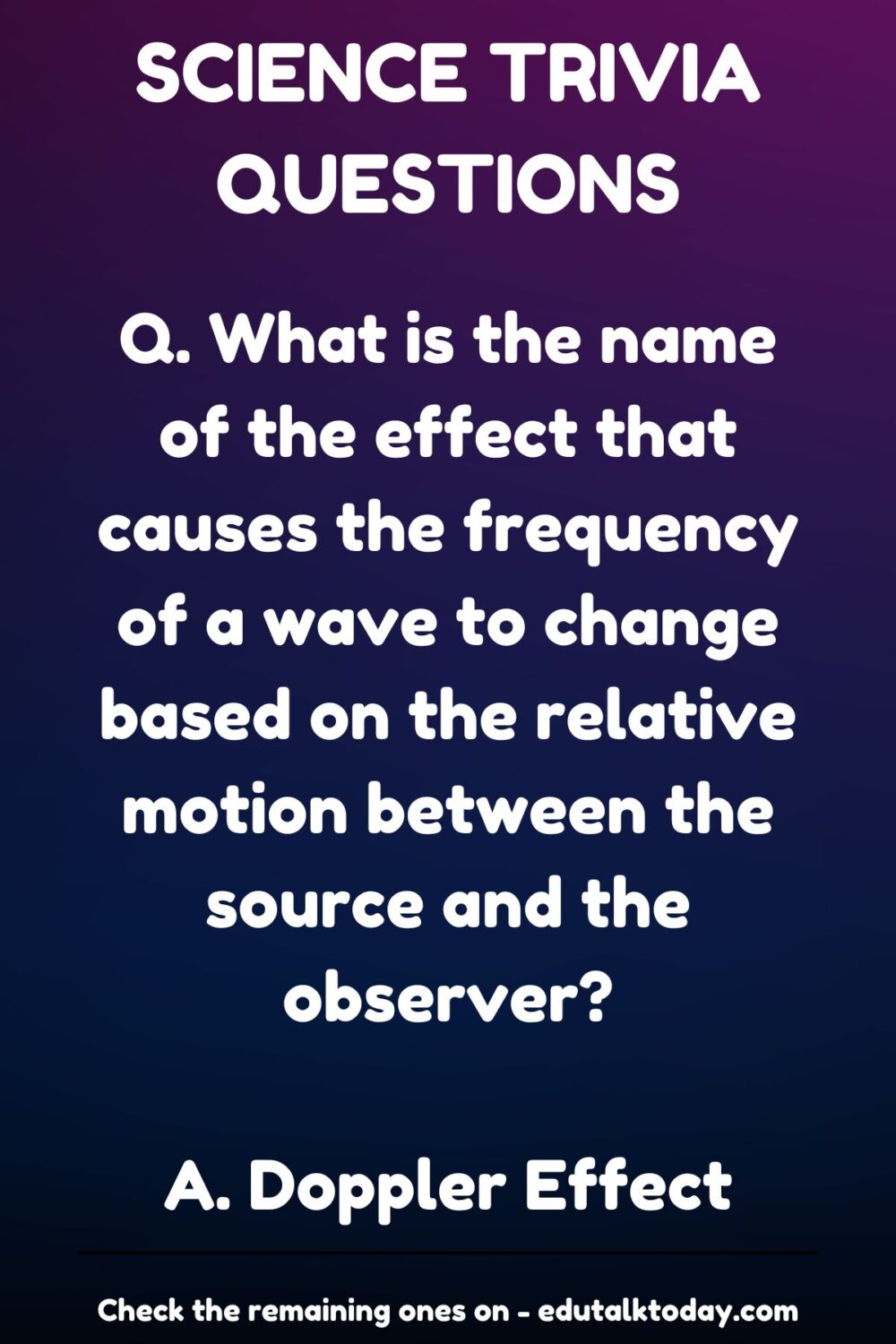
Q. Which planet in our solar system has the strongest winds?
A. Neptune
Neptune has the strongest winds in the solar system, with speeds reaching up to 2,100 kilometers per hour (about 1,300 miles per hour). These extreme winds are likely driven by the planet’s rapid rotation and its distance from the Sun.
Q. What is the name of the process by which a solid turns directly into a gas, bypassing the liquid phase?
A. Sublimation
Sublimation is the transition of a substance from the solid phase directly to the gas phase without passing through the intermediate liquid phase. A common example is dry ice (solid carbon dioxide), which sublimates at room temperature.
Q. What is the most abundant mineral in the Earth’s crust?
A. Feldspar
Feldspar is the most abundant mineral in Earth’s crust, making up about 60% of it. It is a group of rock-forming minerals that are key constituents of igneous, metamorphic, and sedimentary rocks.
Q. What is the term for the amount of energy required to remove an electron from an atom?
A. Ionization Energy
Ionization energy is the energy required to remove an electron from a neutral atom in its gaseous state. It is a critical concept in chemistry, influencing an element’s reactivity and its place in the periodic table.
Q. Which scientist is credited with the discovery of penicillin?
A. Alexander Fleming
Alexander Fleming discovered penicillin in 1928 when he observed that a mold, Penicillium notatum, produced a substance that killed bacteria. This discovery led to the development of antibiotics, revolutionizing medicine.

Q. In what part of the cell does the Krebs cycle occur?
A. Mitochondria
The Krebs cycle, also known as the citric acid cycle, occurs in the mitochondria of cells. It is a series of chemical reactions used by all aerobic organisms to generate energy through the oxidation of acetyl-CoA.
Q. What is the primary pigment found in plants that absorbs sunlight for photosynthesis?
A. Chlorophyll
Chlorophyll is the green pigment found in the chloroplasts of plants, algae, and cyanobacteria. It plays a crucial role in photosynthesis by absorbing light energy, which is then converted into chemical energy.
Q. Which type of electromagnetic radiation has the shortest wavelength?
A. Gamma Rays
Gamma rays have the shortest wavelength and the highest energy of all types of electromagnetic radiation. They are produced by the most energetic processes in the universe, such as nuclear reactions and the decay of radioactive materials.
Q. What principle explains why an airplane can fly?
A. Bernoulli’s Principle
Bernoulli’s Principle states that an increase in the speed of a fluid occurs simultaneously with a decrease in pressure. This principle helps explain how the shape of an airplane wing generates lift, allowing it to fly.
Q. What law explains the relationship between the volume and pressure of a gas at constant temperature?
A. Boyle’s Law
Boyle’s Law states that the pressure of a given mass of gas is inversely proportional to its volume at a constant temperature. This means that if the volume of the gas decreases, the pressure increases, and vice versa.
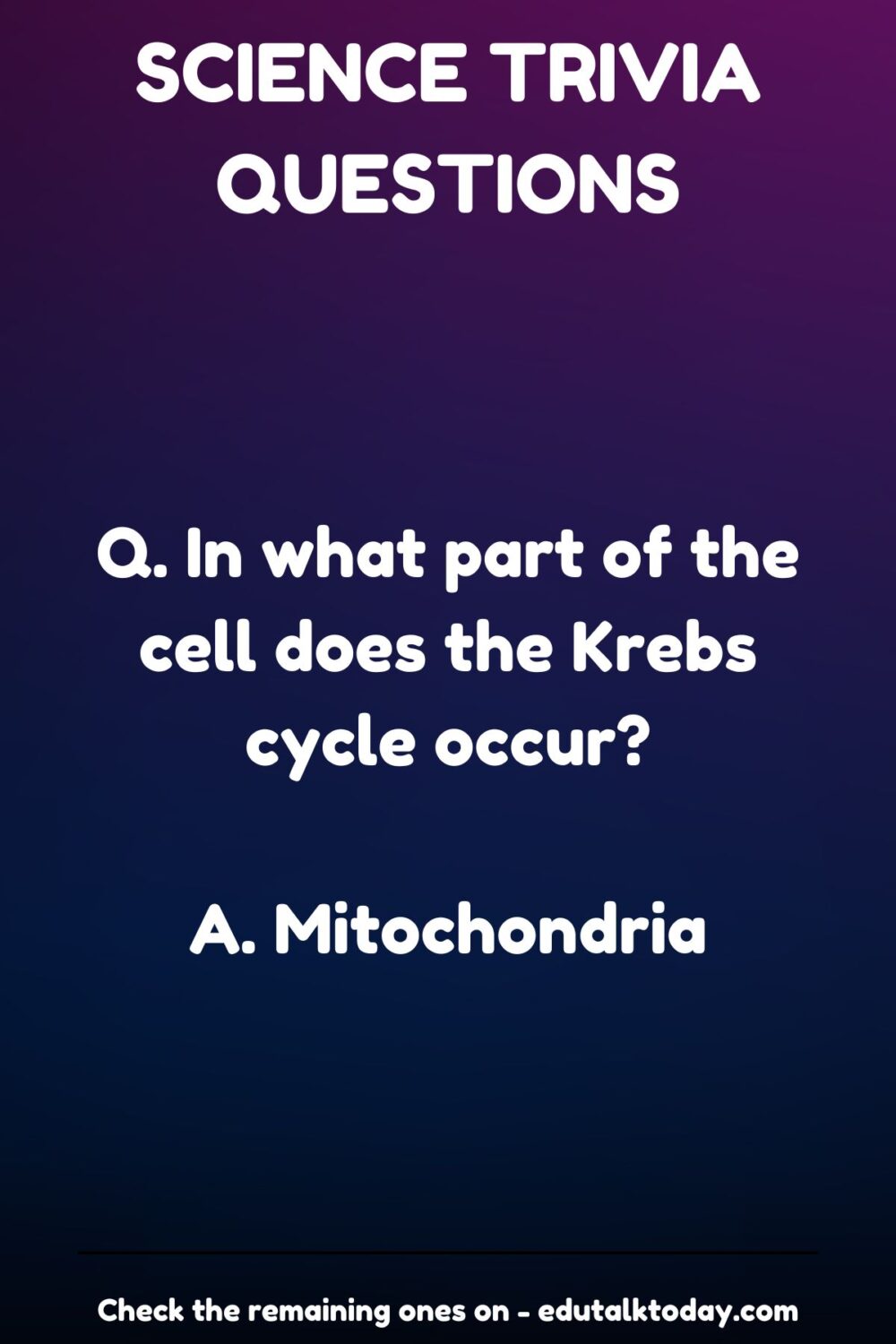
Q. What is the most abundant element in the universe?
A. Hydrogen
Hydrogen is the most abundant element in the universe, making up roughly 75% of all normal matter by mass. It is the primary building block of stars and is involved in the nuclear fusion process that powers them.
Q. What is the name of the process by which plants lose water vapor through small pores on their leaves?
A. Transpiration
Transpiration is the process by which water is absorbed by plant roots and then evaporates from the leaves through tiny openings called stomata. This process is crucial for the movement of water and nutrients from the roots to the rest of the plant.
Q. What is the name of the scientist who formulated the laws of motion and universal gravitation?
A. Isaac Newton
Isaac Newton formulated the three laws of motion and the law of universal gravitation in the 17th century. These laws laid the groundwork for classical mechanics and significantly advanced our understanding of the physical world.
Q. Which gas is commonly known as “laughing gas”?
A. Nitrous Oxide
Nitrous oxide, or laughing gas, is used in dentistry and surgery for its anesthetic and analgesic effects. It causes euphoria and relaxation, which can lead to laughter, hence the name.
Q. What is the largest organ in the human body?
A. Skin
The skin is the largest organ of the human body, covering an average area of about 2 square meters. It serves as a protective barrier, regulates temperature, and allows the sensation of touch, among other functions.

Q. What is the chemical formula for ozone?
A. O₃
Ozone is a molecule composed of three oxygen atoms (O₃). It is found in the Earth’s stratosphere, where it forms the ozone layer that protects living organisms from harmful ultraviolet (UV) radiation.
Q. What is the heaviest naturally occurring element?
A. Uranium
Uranium, with an atomic number of 92, is the heaviest naturally occurring element that is found in significant amounts on Earth. It is used as a fuel in nuclear reactors and as a key material in nuclear weapons.
Q. Which scientist proposed the theory of evolution by natural selection?
A. Charles Darwin
Charles Darwin proposed the theory of evolution by natural selection in his book On the Origin of Species, published in 1859. This theory explains how species evolve over time through the differential survival and reproduction of individuals with favorable traits.
Q. What is the name of the boundary between Earth’s crust and mantle?
A. Mohorovičić Discontinuity (Moho)
The Mohorovičić Discontinuity, or Moho, is the boundary between the Earth’s crust and the mantle. It is characterized by a sudden increase in seismic wave velocities, indicating a change in rock composition and density.
Q. Which subatomic particle is responsible for the chemical properties of an element?
A. Electron
Electrons, the negatively charged subatomic particles that orbit the nucleus of an atom, are primarily responsible for the chemical properties of an element. The arrangement of electrons in different energy levels determines how an element reacts with others.
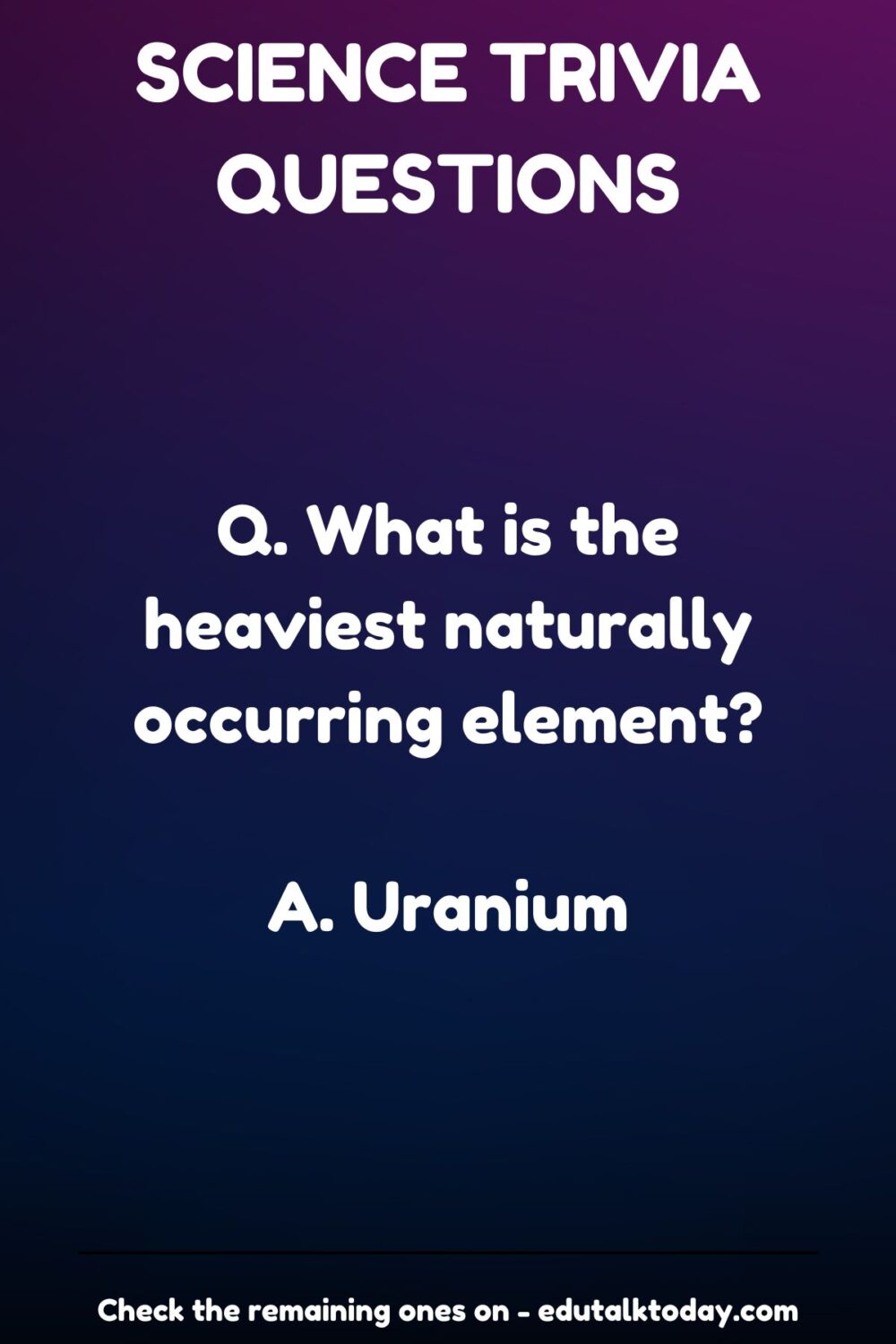
Q. What is the term for the conversion of light energy into chemical energy by plants?
A. Photosynthesis
Photosynthesis is the process by which plants, algae, and some bacteria convert light energy, usually from the sun, into chemical energy in the form of glucose. This process also produces oxygen as a byproduct.
Q. Which disease is caused by the deficiency of Vitamin C?
A. Scurvy
Scurvy is a disease caused by a deficiency of Vitamin C, which is essential for the synthesis of collagen. Symptoms include bleeding gums, weakness, anemia, and skin problems. Historically, it was a common ailment among sailors.
Q. What is the name of the phenomenon where two waves combine to form a wave of greater amplitude?
A. Constructive Interference
Constructive interference occurs when two or more waves overlap and combine to form a wave with a larger amplitude than any of the original waves. This is commonly observed in sound waves, light waves, and water waves.
Q. What part of the brain is primarily responsible for regulating balance and coordination?
A. Cerebellum
The cerebellum, located at the back of the brain, is primarily responsible for regulating balance, coordination, and fine motor control. It ensures smooth and coordinated movement by integrating sensory inputs and fine-tuning motor activity.
Q. What type of bond is formed between two water molecules?
A. Hydrogen Bond
Hydrogen bonds are weak bonds that form between the slightly positive hydrogen atom of one water molecule and the slightly negative oxygen atom of another. These bonds give water many of its unique properties, such as high surface tension and the ability to dissolve many substances.
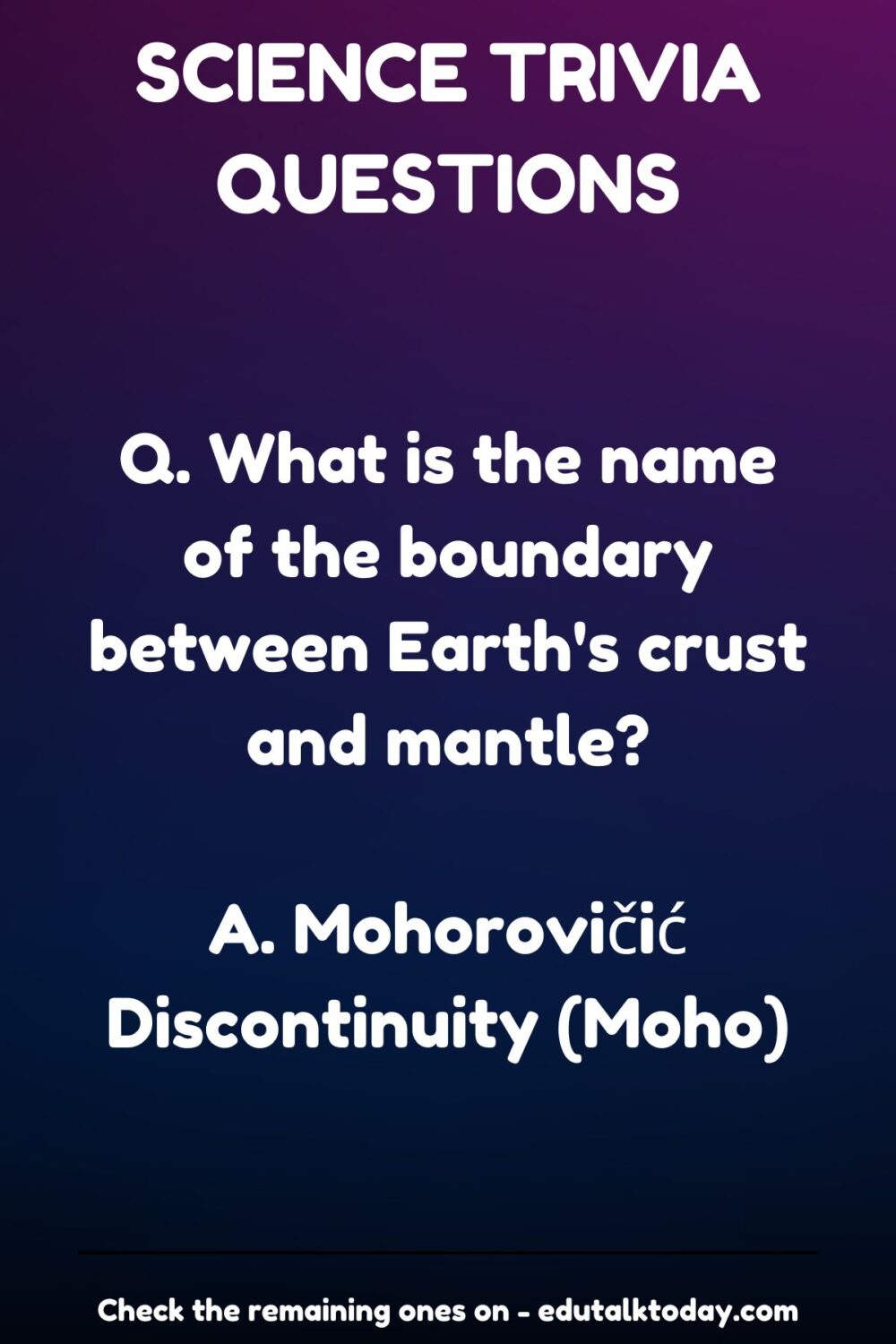
Q. What is the name of the process by which a liquid changes into a gas below its boiling point?
A. Evaporation
Evaporation is the process by which molecules at the surface of a liquid gain enough energy to enter the gaseous state. This occurs at temperatures below the boiling point and is a key process in the water cycle.
Q. What is the primary function of red blood cells?
A. Transporting Oxygen
Red blood cells are responsible for transporting oxygen from the lungs to the rest of the body and returning carbon dioxide to the lungs for exhalation. They contain hemoglobin, a protein that binds oxygen and gives blood its red color.
Q. What is the term for the minimum amount of energy required to start a chemical reaction?
A. Activation Energy
Activation energy is the minimum amount of energy needed for reactants to undergo a chemical reaction. It is the energy barrier that must be overcome for the reaction to proceed, often provided by heat or light.
Q. What element is most commonly used as a semiconductor in electronics?
A. Silicon
Silicon is the most widely used element in semiconductor devices, such as transistors and diodes, due to its excellent electrical properties and abundance in the Earth’s crust. It is the backbone of modern electronics and computing.
Q. What type of electromagnetic radiation is used in medical imaging to see inside the human body?
A. X-rays
X-rays are a type of high-energy electromagnetic radiation that can pass through soft tissues but are absorbed by denser materials like bone. This makes them ideal for medical imaging, such as in X-ray radiography.
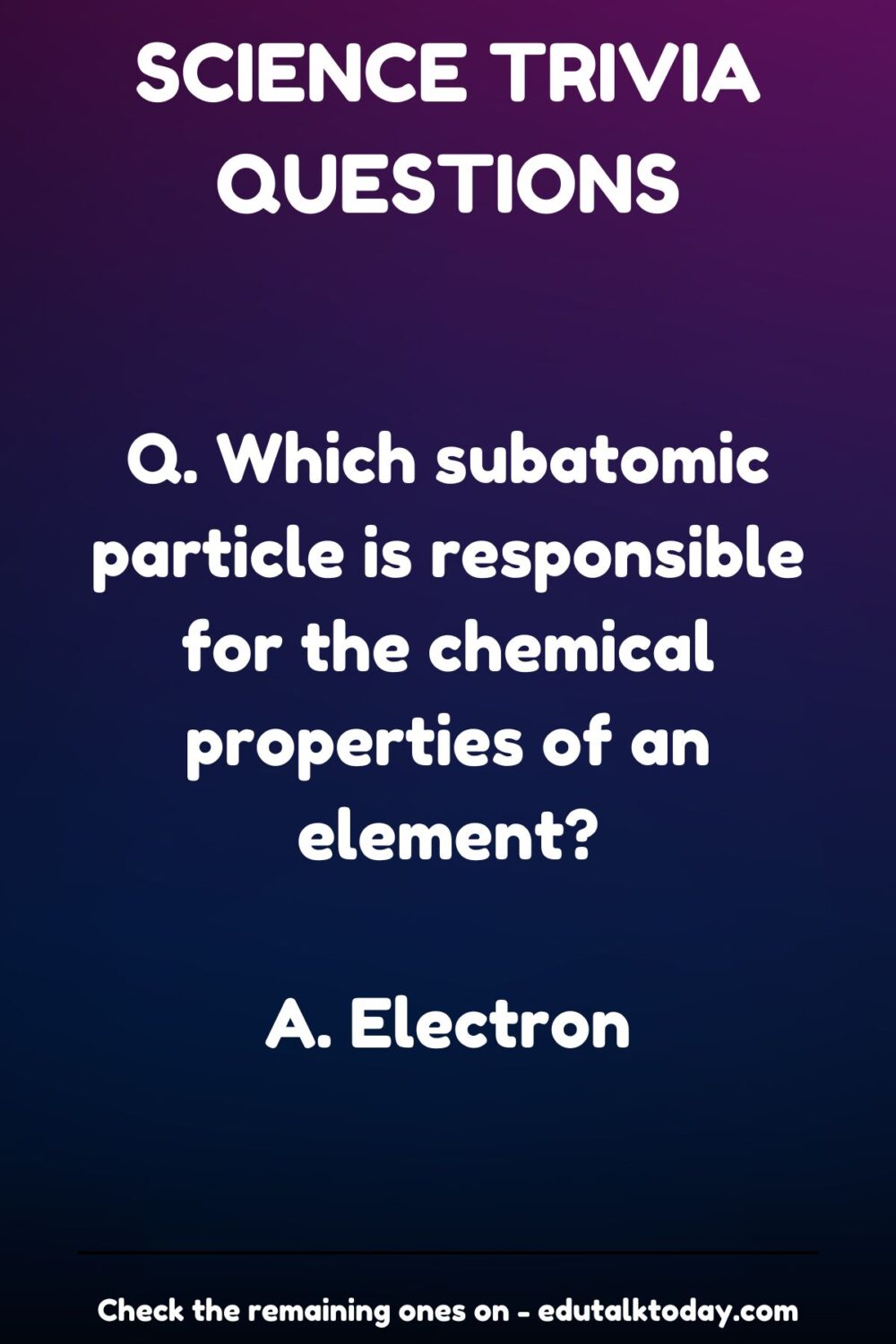
Q. What is the term for an organism that produces its own food using sunlight or chemical energy?
A. Autotroph
Autotrophs are organisms that produce their own food from inorganic substances. They use light energy (in the case of photosynthesis) or chemical energy (in chemosynthesis) to convert carbon dioxide and water into glucose and oxygen.
Q. What is the name of the process by which an unstable atomic nucleus loses energy by emitting radiation?
A. Radioactive Decay
Radioactive decay is the process by which an unstable atomic nucleus loses energy by emitting particles or electromagnetic waves. This process results in the transformation of the original element into a different element or isotope.
Q. What is the unit of measurement for the amount of substance in the International System of Units (SI)?
A. Mole
The mole is the SI unit for the amount of substance. It is defined as the amount of substance that contains the same number of entities (such as atoms, molecules, or ions) as there are in 12 grams of carbon-12, approximately 6.022 × 10²³ entities.
Q. What is the term for the movement of molecules from an area of high concentration to an area of low concentration?
A. Diffusion
Diffusion is the movement of molecules or particles from an area of high concentration to an area of low concentration until equilibrium is reached. This process occurs in gases, liquids, and solids and is essential in many biological processes.
Q. Which planet in our solar system has the most moons?
A. Saturn
Saturn has the most confirmed moons in the solar system, with at least 83 known moons as of recent counts. Its largest moon, Titan, is larger than the planet Mercury and has a thick atmosphere, making it unique among moons in our solar system.
Q. What is the scientific term for animals that maintain a constant body temperature regardless of the environment?
A. Endotherms
Endotherms, also known as warm-blooded animals, maintain a constant internal body temperature through metabolic processes, regardless of external environmental conditions. Mammals and birds are examples of endotherms.






